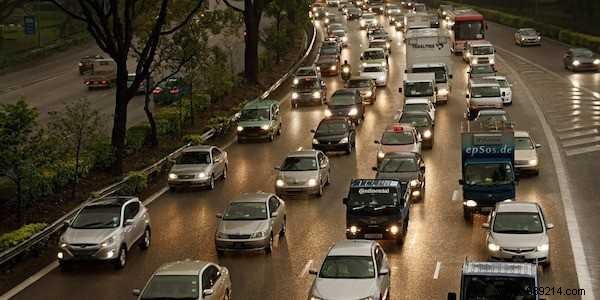
Climate change and the devastating effects of pollution on our planet have become essential topics.
The consequences of pollution related to carbon dioxide emissions are significant.
Climate change is creating devastating storms and disrupting crops (and therefore our food chain).
It is indisputable that our planet is suffering.
But what can we do concretely to help and fight against climate change?

It is true that melting icebergs and tornadoes destroying everything in their path are forces against which an individual cannot do much.
That said, we must not give up. There are things you can do for our planet and for generations to come.
Here are 10 simple tips to reduce your carbon footprint right now:
It's not often that we think about the energy impact of light bulbs.
One easy thing you can do to help the planet is to change your conventional light bulbs to energy-saving ones.
The positive effects are substantial:a single energy-saving bulb can reduce your carbon footprint by 600 kg of carbon dioxide over its entire lifespan.
If all homes in France exclusively used energy-saving light bulbs, we would reduce our electricity consumption for lighting by 50%.
It deserves to take out the stepladder and change a few light bulbs, right?
To buy now, we recommend these LED bulbs.
When you turn off your electrical appliances completely, it's not only good for the appliances, but also for the planet.
It is also ideal to unplug chargers (mobile phones, laptops, etc.) when you are not using them.
Do you tend to leave your charger plugged in, your digital TV box not turned off and your computer on standby?
Then it's high time you changed your geek habits.
According to several studies, you can save up to €100 per year just by completely switching off electrical appliances when they are not in use. Including its Internet box!
To discover: 26 Simple Tips To Save Energy At Home.

The statistics are frightening:1 kg of carbon dioxide is emitted every 4 seconds by European cars.
Every year in Europe, this represents 4.9 billion kg of carbon dioxide that is added to the atmosphere because of cars.
The advantages of carpooling are obvious:sharing a trip with 2 or, even better, 3 people drastically reduces carbon dioxide emissions.
In the same way, public transport reduces the number of cars in circulation.
And if you live in a big city, you surely have the possibility of renting a bike for the year like the Vélib' in Paris.
To discover: 9 Sites to Know for Cheap and Green Travel.
Unlike desktop computers, laptops are designed to be energy efficient.
Depending on the model, a laptop uses up to 80% less energy than a desktop computer.
Because laptops are battery operated, great design efforts are made to save power.
Therefore, they are more suitable for reducing carbon dioxide emissions than desktop computers.
Did you know that when you buy bottled water, you are doing the planet a disservice?
Why ? First, think about the energy needed to produce all those plastic bottles (plastic is made from petroleum).
Then think about the waste produced once the bottles are thrown away (often not recycled).
There's also the transport of bottles to the supermarket and then to your house, which further increases the amount of carbon dioxide released.
In most Western countries, tap water is perfectly safe to drink.
And if you really don't want to drink tap water, get a tap water filter here.
It will cost you less than buying bottles and you will significantly reduce your carbon footprint.
These simple gestures help control the temperature of your home, but they can also make a difference for our planet.
Lowering the thermostat by just 1 degree in winter and raising it by just 1 degree in summer will have a real impact on your electricity bill.
Similarly, turning off the heat when you're away can reduce your bill by up to 15%.
Shutters are also a simple tool that many people overlook.
Open the shutters in the winter during the day to let sunlight in and warm your home. At night, close them to keep the heat in.
In summer, close the shutters during the day to keep your home cool. At night, open them to let the cooling breezes in.
In any case, if you don't have a thermostat at home, consider taking the plunge, because it will save you a lot of money on your bills while reducing your carbon footprint.
We recommend this thermostat that you can control via your smartphone.
To discover: Close Shutters, Curtains, Blinds at Night to Consume Less Heating.

Do you like to eat watermelons all year round? These fruits may be delicious, but you have to realize that they probably don't grow in your area.
By purchasing locally grown seasonal fruits and vegetables, you significantly reduce the carbon footprint of your diet.
According to the Worldwatch Institute, fruits and vegetables travel no less than 2500 km on average between the farm and your supermarket!
We bet you can easily find great fruits and vegetables grown near you.
It just takes a little effort.
To discover: Do you know the Seasonal Fruits and Vegetables?
This is surely the most direct way to reduce your carbon footprint.
Trees provide free shade, produce oxygen and consume carbon dioxide.
By the way, did you know that a single tree, even a young one, absorbs 6 kg of carbon dioxide per year?
As an adult, a tree absorbs 22 kg of carbon dioxide!
A single 10-year-old tree is enough to produce enough oxygen for the survival of 2 people.
If you are lucky enough to have a garden, you know what you have to do!
To discover: Here is a Little House in the Woods Built in 6 Weeks For 3,500 Euros!
Ever since the advent of media in digital format, there has been a debate about the carbon footprint of digital newspapers versus that of paper newspapers.
In terms of carbon footprint, a printed newspaper is roughly equivalent to its weight in carbon dioxide emissions.
That said, reading your newspaper on a computer requires a significant amount of energy, depending on the device you use.
The best policy is to be mindful of the medium used to read your newspaper.
If you prefer to read the newspaper online, consider consuming as little energy as possible.
This means that you should favor an unplugged laptop or a smartphone rather than a plugged-in desktop computer.
If you read the newspaper in print format, consider recycling your newspaper every day.
To discover: 25 Surprising Uses of Newsprint.
A microwave may not be the classiest way to cook.
On the other hand, a microwave oven is much less energy intensive than an electric oven.
Concrete example: a cooking time of 15 minutes in a microwave is equivalent to 1 hour in an electric oven.
This represents a 20% energy saving!
At a minimum, try to use your microwave when boiling water.
Not only is it more efficient and economical, but it doesn't alter the taste.
If you must use your oven, consider using the top of the oven rather than the bottom. Why ? As the heat rises, the cooking time will be reduced.
Do you know any other tips for reducing your ecological footprint? Share them with us in the comments. We can't wait to read you!